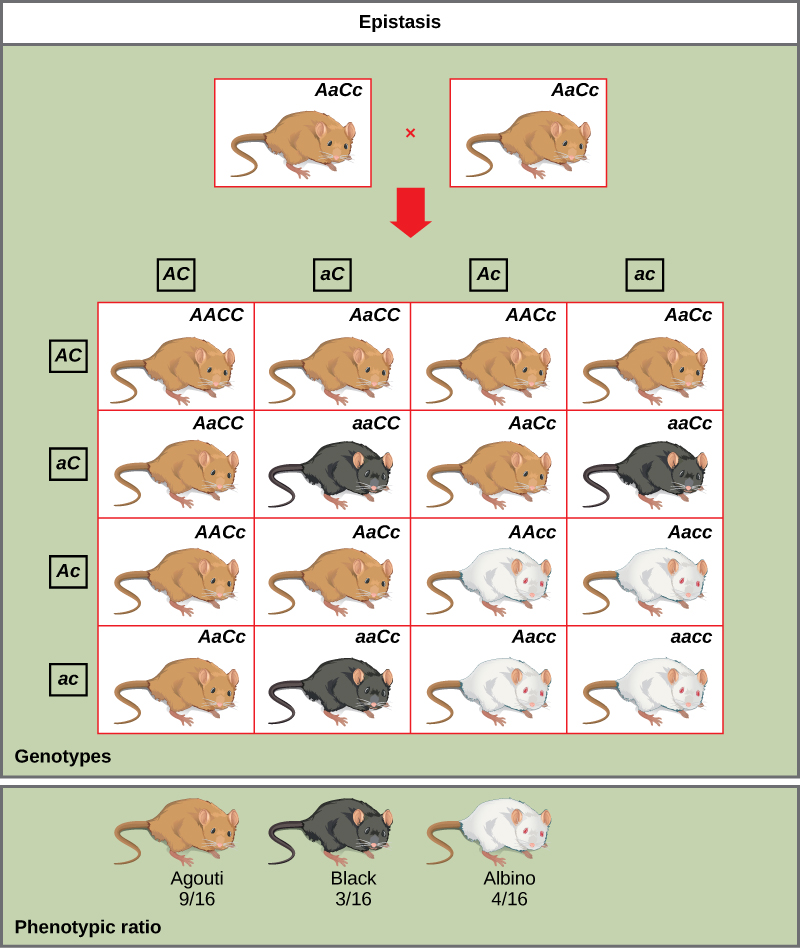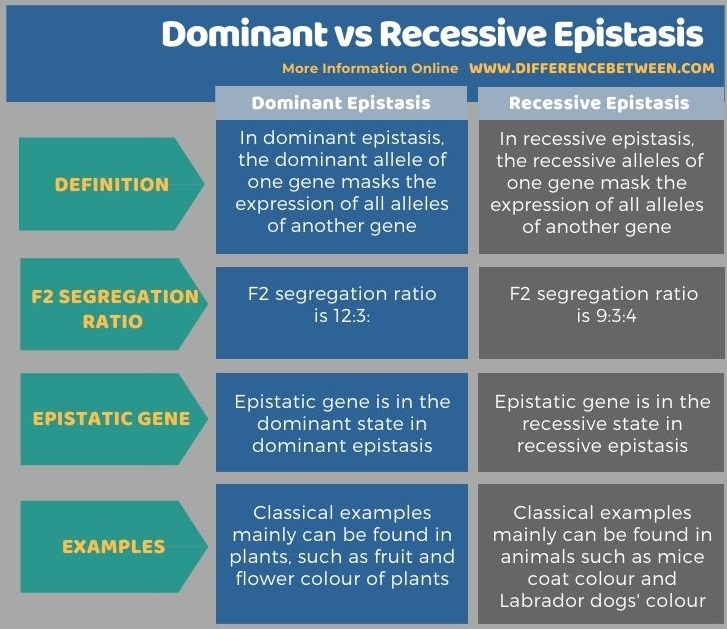Difference Between Dominant and Recessive Epistasis
The key difference between dominant and recessive epistasis is that in dominant epistasis, the dominant allele of one gene masks the expression of all alleles of another gene, while in recessive epistasis, the recessive alleles of one gene mask the expression of all alleles of another gene.
Epistasis is a phenomenon or a type of polygenic interaction where one gene controls the phenotype of another gene for a trait. Both genes have an influence on the physical appearance of the trait, but the one that shows epistasis masks the effect of the other. Genes that show epistasis can be dominant or recessive. Therefore, dominant and recessive epistasis are different types of epistasis.
CONTENTS
1. Overview and Key Difference
2. What is Dominant Epistasis
3. What is Recessive Epistasis
4. Similarities Between Dominant and Recessive Epistasis
5. Side by Side Comparison – Dominant vs Recessive Epistasis in Tabular Form
6. Summary
What is Dominant Epistasis?
In some instances, a dominant allele at one locus masks the phenotype of a second locus. This is called dominant epistasis. The fruit and flower colour of plants is a common example used to explain dominant epistasis. Fruit colour in summer squash is expressed in this way. The homozygous recessive expression of the W gene (ww) coupled with a homozygous dominant or heterozygous dominant expression of the Y gene (YY or Yy) in summer squash produces yellow fruit, while the wwyy (both genes recessive) genotype produces green fruit. However, if a dominant copy of the W gene is present in the homozygous or heterozygous form, the summer squash will be a white fruit regardless of the Y alleles.
In sorghum, the grain is either pearly or chalky. When a plant with pearly grain and another with chalky grain are crossed, the resulting F1 population is pearly. The F2 population segregation pattern is 3 pearly: 1 chalky. Similarly, the grain colour is either red or white. When a plant with red grain and another with white grain are crossed, the resultant F1 population is red. And the F2 population segregation pattern is 3 red: 1 white. The red colour of the grain masks the expression of another character; it is either pearliness or chalkiness of the grain. When the grain colour is white, it is possible to say whether the grain is pearly or chalky. But when the grain is red, it is not possible to say whether the grain is pearly or chalky. The classical F2 segregation ratio of 9:3:3:1 becomes modified into 12:3:1 in dominant epistasis.

Figure 01: Epistasis
There are no simple examples of dominant epistasis in humans. However, scientists believe this is one of the mechanisms that are involved in complex diseases such as Alzheimer’s disease, autism, and diabetes.
What is Recessive Epistasis?
In recessive epistasis, the recessive alleles of one gene mask the phenotypic expression of a second gene. In other words, when one gene is homozygous recessive, it hides the phenotype of the other. A well-known example of recessive epistasis is pigmentation in mice. The wild type coat colour, agouti (AA) is dominant to coloured fur (aa). Anyhow, a separate gene (C) is necessary for pigmentation production.
A mouse with recessive c allele at this locus is unable to produce pigment and is albino regardless of the allele present in locus A. Therefore, the genotypes AAcc, Aacc, and aacc all produce an albino phenotype. In this case, the C gene is epistatic to the A gene. The classical F2 segregation ratio of 9:3:3:1 becomes modified into 9:3:4 in recessive epistasis.
What are the Similarities Between Dominant and Recessive Epistasis?
- They are genetic interactions.
- They are both types of epistasis.
- In both phenomena, alleles of one gene mask the phenotype of alleles of another gene.
- They are extremely important for gene expression and genetic diversity.
What is the Difference Between Dominant and Recessive Epistasis?
The genes of an individual are not expressed isolated from one another; instead, they function in a common environment. Therefore, interactions between genes occur. The interactions between genes are antagonistic in epistasis, one gene masking the expression of another. In dominant epistasis, the dominant allele of one gene masks the expression of all alleles of another gene, whereas, in recessive epistasis, the recessive alleles of one gene mask the expression of all alleles of another gene. Thus, this is the key difference between dominant and recessive epistasis.
The below infographic tabulates the differences between dominant and recessive epistasis for side by side comparison.

Summary – Dominant vs Recessive Epistasis
Epistasis can be defined as a gene interaction where one gene interferes with the phenotypic expression of another non-allelic gene. The gene that masks the phenotypic expression of other non-allelic gene is called the epistatic gene. The gene that is suppressed by the epistatic gene is called the hypostatic gene. There are different types of epistasis as dominant and recessive. Epistatic gene is in the dominant state in dominant epistasis while epistatic gene is in the recessive state in recessive epistasis. Thus, this is the summary of the difference between dominant and recessive epistasis.
Reference:
1. “Dominant vs Recessive Epistasis: Example & Analysis.” Study.com. Available here.
2. “Epistasis.” Biology Dictionary, 27 Mar. 2019, Available here.
Image Courtesy:
1. “Figure 12 03 05” By CNX OpenStax – (CC BY 4.0) via Commons Wikimedia
ncG1vNJzZmivp6x7pbXFn5yrnZ6YsqOx07CcnqZemLyue8OinZ%2Bdopq7pLGMm5ytr5Wau26wzqagp5meqXqiusNmqZ6blajAqsLEZpypoaOprrS10mg%3D